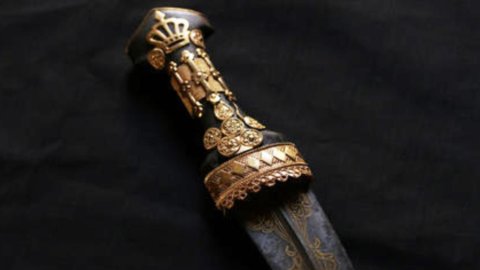Famous as a sculptor and at the same time musician and painter, Pietro Canonica was one of the few Italians who was able to observe the Islamic east of Central Asia in the early years of the twentieth century. The precious objects exhibited in the Perfumes of the East exhibition, at the Pietro Canonica Museum of Villa Borghese in Rome from 4 December to 8 January 2016, come from different areas of the Middle and Far East and have been collected by the artist in different periods and circumstances different.
In order to explore this intense relationship with the Orient, a path has been prepared that winds through three rooms on the ground floor of the Museum to highlight precious artifacts such as ancient Persian dishes, Turkish jugs, water handles and the golden dagger of King Faisal I. Objects received as gifts or purchased during his travels, such as Arab costumes, caftans, Islamic and Japanese weapons, which speak of different worlds and civilizations, loved and appreciated by Pietro Canonica to the point of collecting paintings with Orientalist subjects, such as those of Alberto Pasini, exhibited here.
Canonica's relations with the East are further documented by numerous photographs taken during his long business trips and on the occasion of the inaugurations of his monuments.
In his seventy years of artistic activity, Pietro Canonica (Moncalieri 1869 – Rome 1959) went through a troubled but eventful historical period, always remaining faithful to his conception of art in a time of great changes in which tastes and innovative artistic tendencies: Symbolism, Futurism, Abstractionism.
In 1927, the commission obtained from Turkey for the execution of a bust (lost), a statue and an equestrian monument to the president of the new Republic, Kemal Atatürk, for the city of Ankara, brought Canonica to the neighboring Islamic country, where several Italian artists had worked years earlier and where architects of Italian origin such as Giulio Mongeri were still active. This first successful experience was followed by that of 1928, for which he was commissioned the Monument to the Turkish Republic for Taksim Square in Istanbul and that of 1932 for the Equestrian Monument to Atatürk for the central square of Smyrna. Plaster models, sketches and photographic documentation are conserved in the Canonica Museum.
It was on the occasion of those first trips that Canonica began to bring back artifacts characteristic of the Islamic East, such as carpets and furnishings. A second direct contact with the Islamic world occurred in 1932-'33, when he was commissioned a bust and an equestrian monument for Faysal I, king of Iraq, represented as a knight of the desert, in Arab costume, to be placed in Baghdad.
Also in 1932, the artist was also commissioned to create a statue dedicated to ?Abd al-Mu?sin Sa?dun (1879-1929), Faisal's Iraqi prime minister. However, this work is known only through some photos and the model of the head which is kept in this museum. Among the artist's patrons also the East closest to us: Egypt, loved and frequented by Italians since the opening of the Suez Canal (1869). The Museum owns a model depicting the bust of King Fuad of Egypt and a sketch for the monument to Khedive Ismail Pascià financed by the Italian colony of Alexandria in 1929, but inaugurated only later in 1938.
The portraits and commemorative monuments created by Pietro Canonica in Turkey, Iraq and Egypt allowed the artist to travel extensively in the East at the beginning of the twentieth century, on often difficult routes where few at the time ventured. During these long journeys it is easy to imagine the Piedmontese sculptor fascinated by the dazzling beauty of the Orient. It is very probable that from the crowded bazaars of those distant cities Pietro Canonica wanted to bring with him, as a keepsake, precious objects and fabrics that had sparked his artistic imagination. One thinks of the splendid brocaded silk caftan and the green silk velvet female gilet decorated with gold applications, or the small red velvet saddle blanket embroidered with gold threads, characteristic artifacts of that Islamic area ranging from Turkey up to all of North Africa.
As was customary in artist's ateliers at the turn of the XNUMXth and XNUMXth centuries, evidence from the Far East could not be missing, and Canonica possessed a splendid XNUMXth century Japanese samurai armor, as well as some "yari" spears which we can still admire here.





